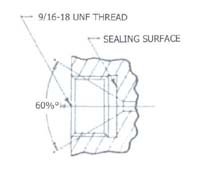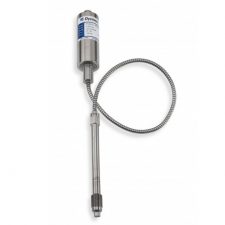PT4194 Series
The PT4194 transmitters provide the industry standard 4 – 20 mA amplified signal designed to work with DCS and PLCs. The PT4194 comes equipped with Auto-Zero functionality which provides the user the ability to install the transmitter right out of the box with just using the zero push button after installation. The PT4194 features a 1/2-20 UNF thread for simple and easy installation in standard transducer mounting holes.
The PT4194 Series includes models PT4194 and TPT4194.
- Auto-Zero functionality
- Oil fill meets FDA requirements
- Accuracy better than ±0.5%
- DyMax® coated convoluted SST wetted parts
- 4 – 20 mA output
- No span or zero pots
Certifications | Approvals
EU Declaration of Conformity for Flush Mount mA Pressure Transmitters
Training’s
Dynisco Pressure Sensor Care and Maintenance
Learn about the proper care and handling of your Dynisco Pressure Sensors
Collateral
From breakthrough technology in the industry’s most complete line of sensors to renowned quality and performance in indicators, controls, and analytical instruments Dynisco has demonstrated the skill, experience and know-how that not only deliver the right solution for your unique application, but also provide unparalleled customer support.
Datasheets
Relevant Articles
Understanding Pressure Measurement Needs of Plastic Manufacturing
Divided into 3 sections, obtain a general understanding of pressure transducer basics, the types of plastic extrusion, and the benefits of pressure transducers.
Tech Notes
Closed Loop Pressure Control for the Extrusion Process
Extrusion is a continuous process and successful economic production depends on maintaining stable output and melt quality at an accurately controlled rate. Current screw design technology, the use of DC drives, computerized controllers and raw material testing help to deliver the melt to the extrusion die at relatively constant temperature, pressure and viscosity.
Melt Pressure Measurement: Environmental Effects
The Need For Pressure Measurement in Extrusion In order to maintain the dimensional stability necessary to produce extruded products that meet todays precise quality and tolerance specifications, it is necessary to keep both the output rate and the melt condition constant (1,2). Although it is not possible to measure these quantities continuously, closely related variables such as melt temperature, and constant melt pressure at the die, the output rate can be considered constant.
The Do’s and Don’ts of Pressure Transducers
When specifying a pressure transducer for a process measurement, a number of items have to be considered. Some of the more important ones are discussed in terms of the transducer itself as well as the overall measuring system. This information is user-oriented and serves as a practical guide in the selection and application of strain gage pressure transducers.
The Importance of Monitoring Extrusion Stability
It has long been known that pressure instability for polymer melt entering the die usually results directly in ouput variation. Instrumentation used in these early studies was too delicate and expensive to be practical for routine commercial use. An excellent article written by B. H. Maddock, covering some of his early studies is title “Measurement and Analysis of Extruder Stability.”
I’m afraid that I have to respond to your question with a question. Do you want an accurate signal from the transducer during the vacuum part of the process? If so, the answer to the original question is “no”!
If the real question was, “Will the transducer be harmed by a vacuum?”, then the answer is “no”. Remember a full vacuum is 0 psia or -15 psig. Compared to the full scale range of a transducer of 0-500 psig and probably higher, 15 psi is almost nothing. The transducer will barely notice anything different. The construction of the tip and diaphragm is such that a vacuum causes only a tiny fraction of stresses that it is designed to withstand.
“But suppose,” I hear you ask, “I want just an indication of vacuum, not absolute accuracy.” Now I must become equivocal. It will probably work. We have performed some testing here, on units from our stock, that indicates a fairly accurate negative output corresponding to increasing vacuum, i.e. output becomes more negative as pressure goes below atmospheric. But this depends on a perfectly filled capillary system. In an ideal world, I would have no qualms about recommending melt pressure transducers for these applications. Since reality is often not ideal and the transducer may not be perfect, a fact we do not like to admit, the output in vacuum may not have the same accuracy as it would for a pressure measurement. Nevertheless, most transducers should give a negative signal in vaccum.
Two caveats – Do not try this with an amplified model such as a 2-wire transmitter. The output cannot go below 4 mA enough to be meaningful. Secondly, if there are significant temperature variations in the process the change in tip temperature could cause a much greater change in output than the vacuum.
Perhaps it is time for a little lesson on screw threads! I am sure that everyone knows that “1/2” is the major diameter of the thread in inches and “20” is the number of threads per inch. For those who don’t know, the UN refers to United Screw Thread which is one of the thread forms recognized as an American National Standard. The standard further defines the dimensions, shape height, depth, angles, tolerances, etc. of each thread. The “F” following the “UN” designates “Fine-Thread Series”. These series (there are also “C” for “Coarse-Thread Series” and “EF” for “Extra-Fine-Thread Series”) are particular combinations of diameter and threads per inch that are selected based on the application. For example, Coarse-Thread devices are used for threading into lower tensile strength materials and softer materials or where rapid assembly/disassembly is desirable or where corrosion or damage to threads is likely. The Fine-Thread Series are found in most other applications where the Coarse threads are not appropriate.
The “2A” or “2B” calls out the thread class. Without going into a long dissertation, this defines the tolerances and allowances on all the parameters of the thread. The “_A” classes are for external threads and the “_B” for internal threads. (Now, I hope you see why the transducer is specified with the “-2A” designation and the mounting well is “-2B”.) The Class 2 fit is used on most high quality commercial products. Class 1 is looser and used only for rapid assembly/disassembly and where shake or play is not objectionable. Conversely, Class 3 is found on exceptionally high precision products.
Anyone, with an insatiable curiosity, can consult any mechanical engineering handbook for pages of tabulations of all threads, their dimensions and tolerances. I am indebted to the Dynisco Drafting Department for their assistance in providing me with more information than I ever wanted to know about threads.
It seems only fair that we discuss the pressure fitting of the general purpose transducers, after a dissertation on the threads of the standard melt pressure models. This should satisfy the equal time requirement.
Providing a good seal in plumbing connections, where system pressures exceed 10,000 psig, presents a significant challenge. O-rings and gaskets may leak. Pipe threads cannot withstand the forces generated by the high pressures. (Please remember that we must test the units to at least 1.5 times rated pressure for our overpressure specification.) Over 50 years ago, NBS (now NIST) developed a design for high pressure fittings that addresses these issues. This cone and thread style was further refined by Autoclave Engineers and others, but most people in our industry refer to the numbering system used by AE. (In “F250C” the “F” means a female fitting and “250” designates its use for 1/4 inch heavy wall tubing.)

As you can see in the above sketch, the high pressure fitting eliminates the need for sealing material by substituting a small diameter 60° cone as a metal to metal seat. By subjecting the pressure to a limited area, the forces that must be held by the threads is reduced to acceptable levels

